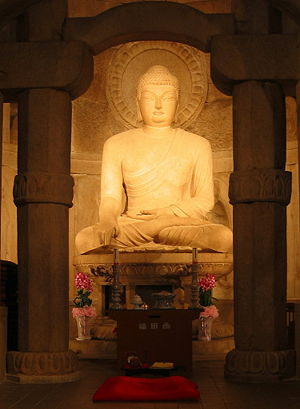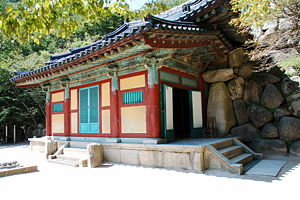Seokguram
| Seokguram | ||||||||
|---|---|---|---|---|---|---|---|---|
 | ||||||||
| Korean name | ||||||||
|
| Seokguram Grotto and Bulguksa Temple* | |
|---|---|
| UNESCO World Heritage Site | |
| State Party | |
| Type | Cultural |
| Criteria | i, iv |
| Reference | 736 |
| Region** | Asia-Pacific |
| Inscription history | |
| Inscription | 1995 (19th Session) |
| * Name as inscribed on World Heritage List. ** Region as classified by UNESCO. | |
The Seokguram Grotto is a hermitage and part of the Bulguksa temple complex. It lies four kilometers east of the temple on Mt. Tohamsan, in Gyeongju, South Korea. The grotto overlooks the Sea of Japan (East Sea) and rests 750 meters above sea level. In 1962, it was designated the 24th national treasure of Korea. In 1995, Seokguram was added to the UNESCO World Heritage List together with the Bulguksa Temple. It exemplifies some of the best Buddhist sculptures in the world. [1]
It is said to have been built by Gim Daeseong and originally called Seokbulsa (석불사, Stone Buddha Temple). Construction began in 742 when Gim Daeseong resigned his position in the king's court or in 751, the 10th year of the reign of King Gyeongdeok of Silla. This time period was the cultural peak of Unified Silla. The grotto was completed by the Silla court in 774, shortly after Gim's death. An old legend stated that Gim was reincarnated for his filial acts in his previous life. The legend relates that the Bulguksa Temple was dedicated to Gim’s parents in his present life while the Seokguram Grotto was dedicated to Gim's parents from a previous life.
It is now one of the best known cultural destinations in South Korea and is reached by taking an hour-long hike through a mountain path. A viewing of the sunrise over the Sea of Japan is especially popular.
Architecture
India began a tradition of carving the image of Buddha in stone, holy images, and stupas into the cliff walls and natural caves. This practice was transferred to China and then Korea. The geology of the Korean Peninsula, which contains an abundance of hard granite, is not conducive to carving stone images into cliff walls. Seokguram is an artificial grotto made from granite and is unique in design. The small size of the grotto indicates that it was probably used exclusively by the Silla royalty.
The grotto is symbolic of a spiritual journey into Nirvana. Pilgrims were to start at Bulguksa or at the foot Mt. Tohamsan, a holy mountain to the Silla. There was a fountain at the entrance of the shrine where pilgrims could refresh themselves. Inside the grotto, the antechamber and corridor represented the earth while the rotunda represented heaven.
The basic layout of the grotto includes an arched entrance which leads into a rectangular antechamber and then a narrow corridor, which is lined with bas-reliefs, and then finally leads into the main rotunda. The centerpiece of the granite sanctuary is a Buddha statue seated in the main chamber. The identity of the Buddha is still debated. The Buddha is seated on a lotus throne with legs crossed. The Buddha has a serene expression of meditation. The Buddha is surrounded by fifteen panels of bodhisattvas, arhats and ancient Indian gods in the rotunda and is accompanied by ten statues in niches along the rotunda wall. The main hall of Seokguram houses a Bojon statue Bodhisattva and his disciples. Forty different figures representing Buddhist principles and teachings are in the grotto. The grotto was built around these statues in order to protect them from weathering. The ceiling of the Seokguram grotto is decorated with half moons, the top is decorated with a lotus flower. Silla architects used symmetry and apparently employed the concept of the golden rectangle.
The grotto is shaped by hundreds of different granite stones. There was no mortar used and the structure was held together by stone rivets. The construction of the grotto also utilized natural ventilation. The dome of the rotunda is 6.84 meters to 6.58 meters in diameter.
Sculpture within the grotto
The main Buddha is a highly regarded piece of Buddhist art. It is 3.5 meters in height and sits on a 1.34 meter tall lotus pedestal. The Buddha is realistic in form and probably represents the Seokgamoni Buddha, the historic Buddha at the moment of enlightenment. The position of the Buddha's hands symbolizes witnessing the enlightenment. The Buddha has a usnisa, a symbol of the wisdom of the Buddha. The drapery on the Buddha, such as the fan-shaped folds at the crossed-legs of the Buddha, exemplifies Korean interpretations of Indian prototypes. Unlike other Buddhas that have a halo attached to the back of the head, the Buddha at Seokguram creates the illusion of a halo by placing a granite roundel carved with lotus petals at the back wall of the rotunda. The pedestal is made of three parts; the top and bottom are carved with lotus petals while the central shaft consists of eight pillars.
Accompanying the main Buddha, in relief, are three bodhisattvas, ten disciples, and two Hindu gods along the wall of the rotunda. Ten statues of bodhisattvas, saints, and the faithful are located in niches above the bas-reliefs. The ten disciples were disciples of Seokgamoni and are lined five on each side of the Avalokitesvara. Their features suggest a Greek influence. The two bodhisattvas are of Manjusri and Samantabhadra. The two Hindu gods are Brahma and Indra.
The Four Heavenly Kings guard the corridor. There are also images of Vajrapanis, which are guardian figures and they are on the walls of the entrance to the corridor, in the antechamber. Eight Guardian Deities adorn the antechamber.
Another notable figure is the Eleven-faced Avalokitesvara, the Bodhisattva of Compassion. It is on the back wall of the rotunda and stands 2.18 meters in height. This figure is the only one of the bas-reliefs facing forward, the others face the side. The Avalokitesvara wears a crown, is dressed in robes and jewelry and holds a vase containing a lotus blossom.
Two statutes from the niches and a marble pagoda that was believed to have stood in front of the Avalokitesvara are missing from the grotto and are believed to have been looted by the Japanese.
Reconstruction
Because of the long periods of abandonment and numerous renovations, many details are disputed amongst scholars, such as the exact layout of the original grotto, the buildings in Bulguksa or the shape of the watercourse, which no longer exists, in front of the temple.
Repair and improvements were undertaken in 1703 and 1758, during the Joseon dynasty. The Japanese Government-General of Chosen conducted restoration works three times, but it faced humidity and other problems. After World War II, in the 1960s, President Park Chung Hee pursued a major restoration project to correct the work done during the Japanese occupation. The interior of the grotto can now only be viewed through a glass wall, installed to protect it from the large number of tourists it attracts.
Gallery
See also
- List of Buddhist topics
- Korean Buddhist temples
- Tourism in Gyeongju
- List of Korea-related topics
- National treasures of Korea
ReferencesISBN links support NWE through referral fees
- National Heritage: Seokguram
- Cultural Heritage: Seokguram
- Excellent reference with a lot of pictures.
Credits
New World Encyclopedia writers and editors rewrote and completed the Wikipedia article in accordance with New World Encyclopedia standards. This article abides by terms of the Creative Commons CC-by-sa 3.0 License (CC-by-sa), which may be used and disseminated with proper attribution. Credit is due under the terms of this license that can reference both the New World Encyclopedia contributors and the selfless volunteer contributors of the Wikimedia Foundation. To cite this article click here for a list of acceptable citing formats.The history of earlier contributions by wikipedians is accessible to researchers here:
The history of this article since it was imported to New World Encyclopedia:
Note: Some restrictions may apply to use of individual images which are separately licensed.


